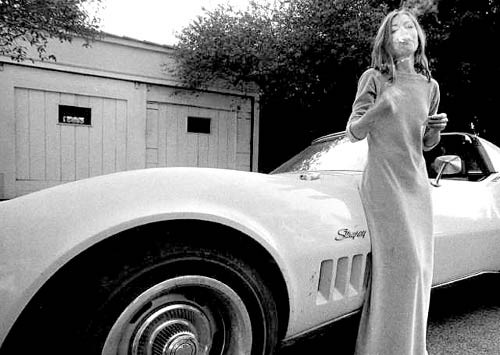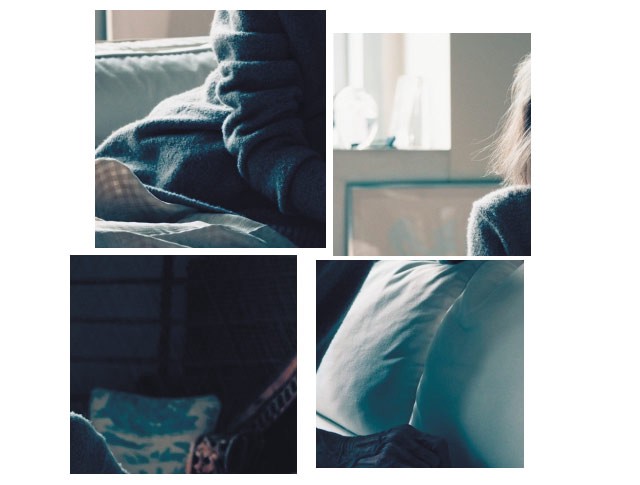Pictures of Joan Didion
by Daniel D’Addario

In the October Vanity Fair — the one with Angelina Jolie’s most recent spin on the cover, this time in an ultra-zoomed-in portrait leaving her looking like a close-up-ready revision of Picasso’s portrait of Gertrude Stein — Joan Didion was depicted in her biennial being-thin tour, occasioned by the upcoming release of her memoir Blue Nights. The picture, taken by Annie Leibovitz, depicts a gaunt and dimly lit Joan, her hair overtaken by wispy flyways and even a small sweater piling upon itself on her frame. Some meager light plays across her face. The photo, in uncopyrighted reproduction, has 625 notes right now on Tumblr, and the actress Zooey Deschanel reblogged it without further comment beyond the reblogging.
The surroundings are creamy — white couch, toile pillow in the background (on an immense chair), a framed picture on the floor (something which I personally have always associated with the haute-WASP lifestyle) — and fade into the background, and Ms. Didion, despite her strong lipstick, is made to loom among them, an unnatural position not merely for a woman of her bearing but for a writer who has made her living lurking on the outskirts of events and of experience. She cannot have known quite how Ms. Leibovitz would photograph her, but she seems, I think, uneasy with the faux-heroic framing, the Queen of the Realm ironically diminished by her age and weakness. Ms. Didion’s expression — pursed lips, eyes open wide — is of an unassaugeable pain, born bravely. Or it is nothing. Or it is the mere human evocation of the emotion :-|, a neutral placeholder.
Ms. Didion is one of the most important figures of both contemporary fiction and nonfiction, and a heart-stopping chronicler of experience — both her own and others’. A writer of her stature and in her time would inescapably be the subject of photography, and there is that famous author photo — reiterated, with variations — of a young and purse-lipped Didion, cigarette in hand, assessing the lens. Ms. Leibovitz’s portrait seems a cruel parody, allowing the surroundings to subsume the woman whose lissomeness became grimness. Any photograph of Joan Didion, given her very specific physicality, will seem unreal (Vanity Fair ran a photo by Brigitte Lacombe of Ms. Didion with Vanessa Redgrave, who played her in the stage adaptation of The Year of Magical Thinking, and it proved nothing but their dissimilarity — but this new take on her felt unsettlingly like a lampoon of the photography-of-Didion style, taking up the most significant signifiers and filling in the rest with cruel intimations of age.

To look at the young Didion (who holds a cigarette like a weapon but whose tight lips seem, perhaps by sympathetic magic, to betray at once a beatific smile and a derisive laugh) and then the current iteration is to see all of what Didion has written about growing older and losing all that once had mattered, without the grace of her prose or the sympathy one allows oneself to feel for an author using her own voice.
There is a reason, based not upon the creation of one’s own image but on a certain intensity and rhyme with her written work, that Ms. Didion’s image adorns so many paperback editions of her books. She is peering spuriously from a car’s driver’s seat on The White Album and clad behind sunglasses, jaw set, on Slouching Towards Bethlehem. The look is her white suit, but even Tom Wolfe isn’t as recognizable.
I have been in the same room as Ms. Didion once ever, at an awards ceremony for student journalists at which she spoke, dedicating an award to the daughter whose death Blue Nights chronicles. She is, as reported by herself, “so physically small,” but she was not, in performing the dedication, shaky. Instead she spoke quickly and robotically as if trying to get through the speech before some catastrophe. She electrified the room to a degree Ms. Leibovitz’s creamy neutral nothing completely elides, not merely by virtue of reputation but by some demonic charisma she still possesses, a cool an inch thick over bottomless reserves of rageful heat.
She also offered the honoree of the prize in her daughter’s name carrots off her plate, which he refused.
The Year of Magical Thinking, a memoir of the loss of Ms. Didion’s husband (while the new book is about the loss of the pair’s daughter) occasioned a spread in the Times magazine, shot by Eugene Richards. Here, Ms. Didion is frail — there is no escaping her physical smallness, no trick a photographer might use to morph her in that way — but dwarfed by her surroundings. Rather than dominating the frame, Ms. Didion, in the most memorable shot, hangs back, in a doorway, her face lower and smaller than a portrait of her dead husband. She does not look at the lens. There is bravery here on the part of subject and artist. There is real contrast with that earlier portraiture, of the confident political essayist, of the former president of her Upper East Side co-op board, all the other many things she is, that makes a statement. All Ms. Leibovitz, ever seeking sensation, shows is disgust with the frailty of the body that masks itself as reverence for the travails of the heart.
Daniel D’Addario is a writer living in Brooklyn who has contributed to publications including The New York Observer, Slate, and Capital New York.
